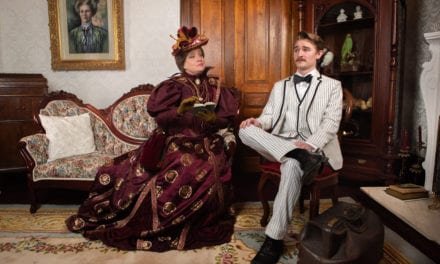PROVO — Unlike so many productions of The Sound of Music, the title song of the Salzburg Marionette Theatre’s production does not have a Maria twirling with her arms outstretched as she sings. Instead, Maria sits on a verdant hill, which sways to the beat of the music. This unusual choice was the first hint of the defining characteristic of the production: with a cast of marionettes instead of people, the creators of this production were free to experiment while still presenting their audience with a familiar product.
The classic Rodgers and Hammerstein musical tells the story of the von Trapp family and their new governess, Maria. As she cares for the seven children she brings joy into their lives by through music. Howard Lindsay and Russel Crouse‘s script not only explores the pleasure of music, but also the importance of standing up for one’s beliefs.
The play contained many little visual surprises, such as the animal puppets that were included in songs like “How Do You Solve a Problem Like Maria?” and “Do Re Mi.” I also appreciated how the characters would express emotion with their full bodies. The jumps for joy, the sudden entrances (some from the ceiling!), and different ways the characters walked were all charming and added an element of cuteness to the stage action. It’s difficult for me to separate Richard Hamburger’s direction and the conventions of puppet theatre, so I don’t know how much of this is typical for a play performed by marionettes and how much of this is Hamburger’s artistic decision making. Either way, these visual were some of the strongest aspects of the show.
 The voice actors for the play were superbly talented and helped add dimension and emotion to the visual component of the show. Christiane Noll’s performance as Maria was touching in the scenes with Captain von Trapp (voiced by Martin Vidnovic), especially at the party. Noll’s rendition of “Do Re Mi” was a highlight of the evening because of her energetic performance. Likewise, Vidnovic’s baritone voice was rich and gorgeous in every note of “Edelweiss.”
The voice actors for the play were superbly talented and helped add dimension and emotion to the visual component of the show. Christiane Noll’s performance as Maria was touching in the scenes with Captain von Trapp (voiced by Martin Vidnovic), especially at the party. Noll’s rendition of “Do Re Mi” was a highlight of the evening because of her energetic performance. Likewise, Vidnovic’s baritone voice was rich and gorgeous in every note of “Edelweiss.”
But the marionette format presented challenges. Because the apron of the de Jong concert hall stage is so big, the puppet stage was placed upstage, far from the audience. This made the puppets (only about two feet tall each) seem very tiny to me, even though I was only seated on the fifth row. Because the action was so far away, I felt like I was watching the show on a small cell phone screen. It’s likely that I missed a lot of the details and nuance in the play, and I pity the people who sat in the rear rows of the balcony, whose experience was probably little more than a radio version of The Sound of Music. Clearly, this production was designed to be staged in a setting much more intimate than the 1,268-seat de Jong concert hall.
 There was also the strange choice of having the mother abbess sometimes played by a real person dressed in a habit; next to the marionettes she appeared to be fifty feet tall. It was never clear why she was played by a human, why she was so tall (to perhaps have her represent God guiding Maria’s life?), or why the character was voiced by an offstage performer (Jeanne Lehman) while the (uncredited) human on stage was pantomiming.
There was also the strange choice of having the mother abbess sometimes played by a real person dressed in a habit; next to the marionettes she appeared to be fifty feet tall. It was never clear why she was played by a human, why she was so tall (to perhaps have her represent God guiding Maria’s life?), or why the character was voiced by an offstage performer (Jeanne Lehman) while the (uncredited) human on stage was pantomiming.
Finally, readers should be aware that the Salzburg Marionette Theatre’s version of The Sound of Music is an edited version of script that runs over an hour shorter than stage productions I have seen. Diehard fans of the musical will miss much of the dialogue (especially in the first act) and snippets of “Sixteen Going on Seventeen” and other songs. For example, the humorous exchange between Maria and the Mother Abbess about the seven children that Maria must care for is dropped completely. As a consequence, a lot of the character development in the play was missing, and the play felt like it was stumbling from one musical number to another. Audience members familiar with the film version will be able to fill in the gaps of the dialogue themselves, however. And I must confess that the edited script made the evening pass very quickly; the novelty of watching marionettes present the play probably could not have lasted over two and a half hours.
Despite the problems of the production, I’m still grateful that I attended. As UTBA’s archives show, puppet theatre is rarely produced in Utah, and it was fun to see some new spectacle. One of the most iconic moments of the film version of The Sound of Music is “The Lonely Goatherd,” which was created with puppets from the Salzburg Marionette Theatre. Seeing the entire production in this format will probably be one of the most unique and memorable theatrical experiences I have this year.







